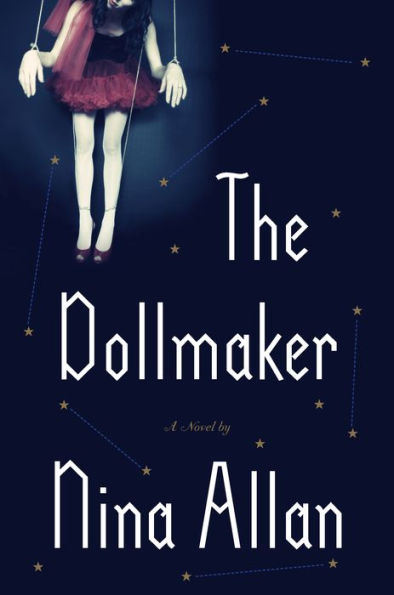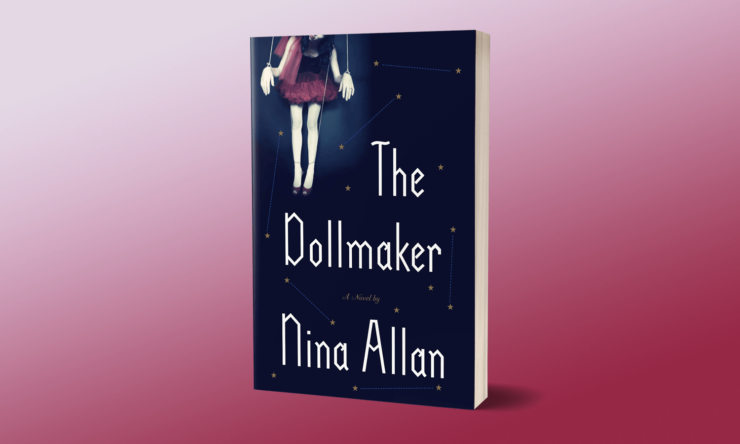If pressed, I’m sure that Nina Allan would say that her new novel, The Dollmaker, takes place in the here and now. I don’t know that I would believe her. The book’s world looks like ours, complete with smartphones and Google Earth, but it’s a planet where trips are still planned by surveyor’s maps, where hotels are selected according to a printed almanac’s recommendations, and where long-distance relationships are conducted by page upon page of handwritten letters. Fairy tales are a motif. “What,” Allan asks her readers, “if a long, long time ago were today?”
Fairy tales may not be simple, but they’re usually straightforward: The story begins at the beginning and proceeds to the end. The Dollmaker doesn’t work like this; just as its hero stitches disparate fabrics for his dolls’ clothes, so Allan entwines separate stories and varying styles to produce a novel greater than the sum of its parts.The book’s central strand narrates, in first person, dollmaker Andrew Garvie’s trip across England to visit Bramber Winters, who he loves and has never met, in the mental hospital where she’s spent most of her life. The second strand is Bramber’s letters to Andrew, which show Bramber slowly coming to grips with her unresolved traumas. The third and final portion of the narrative consists of short stories by Ewa Chaplin, artist, dollmaker, refugee, and fantasist.
The middle of The Dollmaker’s three epigraphs is an extract from a study on the “Death, Funeral & Burial of Dolls” from an 1897 study. Twenty-eight children included in that survey “expressly say that dolls have no souls, are not alive, and have no future life.” The two protagonists of The Dollmaker acknowledge that dolls aren’t alive; Andrew and Bramber’s greater problem is how few people recognize their own present lives and future hopes. Andrew is shy, awkward, and stands just over four feet, nine inches. He likes women, but his only sexual relationships have been with men; he is a successful dollmaker with more friends than customers. Bramber has friends and companions in West Edge House, but on her rare occasions outside, she’s treated as freakish and potentially dangerous. Neither one is happy, neither one initially believes happiness possible.
Dolls are uncanny for their opposed lifelessness and lifelikeness; they seem to be neither one thing nor the other. Good stories have a similar tension: They may be true but not factual; we construct narratives about ourselves, we live and believe these stories while acknowledging that they simplify and streamline reality. As Andrew’s quest—I use the word advisedly—progresses, he plunges ever deeper into story-land, imagining himself as a Galahad or Lancelot, reading incidents from his life into Ewa Chaplin’s stories, and visualizing a decaying rest home as an impenetrable Wagnerian fastness. Bramber too has a story problem. Despite all evidence to the contrary, she tells herself she’s guilty of a monstrous lapse. The Dollmaker reveals itself as a story about two people resisting the temptations of story.
Buy the Book


The Dollmaker
Without delving into spoilers, I liked the first two-thirds of the book more than its final portion. While I appreciated the unconventional resolution to Andrew’s ill-advised and unannounced trip to rescue “his” Bramber, I wasn’t convinced by a late-book development that has Andrew, previously awkward, unsociable, and lonely but entirely sane, holding conversations with a voice in his head.
Because Chaplin’s stories, and the dolls she created to represent them, are so important to the characters, I rather expected that this mysterious figure would play a larger role in The Dollmaker. Her life is mysterious, her tales seem preternaturally linked to the lives of Andrew and Bramber, and her dolls exert a strange fascination, but we never learn much about her. She loiters outside the narrative, but is never invited in. Perhaps Allan wanted her readers left wondering.
Though we never learn as much as we might like about Ewa Chaplin, fictional person, we at least get to read Ewa Chaplin, fictional writer. I’m of two minds about the “Chaplin” stories interspersed throughout the novel. First, and probably most importantly, they work as stories in themselves; they’re not just veiled commentaries on the lives of Andrew and Bramber, though both see themselves in Chaplin’s stories. One or two of the stories were initially published on their own; they’re small gems that still glitter when removed from their novelistic settings. Some may even shine more brightly: The stories, accomplished as they are, don’t always convince as the work of a Polish refugee writing in the middle twentieth century. The last story included feels very much inspired by Brexit and by the ascendant religious right in the current decade. Chaplin also seems two or three decades ahead of her time on gender issues—Surely a devoted reader like Bramber should recognize how unusual it is for a writer who died in the nineties to introduce explicitly nonbinary characters with “they” pronouns? When the fictional Chaplin was writing, even Ursula K. Le Guin was using “he” for the genderfluid people of The Left Hand of Darkness.Perhaps my questions about The Dollmaker have taken up disproportionate space in this review, because I quite liked the book and would happily recommend it. Well before I finished reading this novel, I walked into a bookstore and bought a copy of The Silver Wind, Allan’s newly reissued and expanded novel-in-stories. It’s near the top of my reading pile, and The Dollmaker should be near the top of yours. Like the best fairy tales, it provokes, it challenges, it moves, and it lingers.
The Dollmaker is available from Other Press.
Matt Keeley reads too much and watches too many movies. You can find him on Twitter at @mattkeeley.










